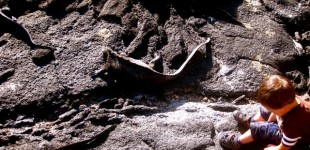Bridget Gleeson writer + illustrator

Ten things I didn’t know about the Galapagos
Discreet Packing. Canada Viagra. Licensed Canadian Pharmacy That Provides Safe
The islands startled me. They’re rougher, colder and more spectacular than I expected – somehow bleak and lush at the same time.
I just got in from a cruise around the Galapagos onboard the Evolution, Quasar Expeditions‘ elegant 32-passenger yacht. Writing about the tour was part of an assignment for the web publication Luxury Latin America – the formal write-up will follow. But for now, somewhere high over Cuba on a flight between Quito and Miami, I’m still trying to put things into context. A list seems in order.
10. The archipelago is huge. Just from glancing at the map, I assumed we’d be island-hopping at a leisurely pace. But on several days of our journey, we had to be back onboard by 5pm so that the Evolution could embark on a 15-hour trip to the next island.
9. The islands are surrounded by terrifyingly deep water. As Tilda Swinton informed me during the BBC’s fantastic ‘Born of Fire‘ documentary, one of the ‘islands’ is just the rocky top of a huge underwater volcano that’s two miles tall. Among other things, it means that the sea seems to be always churning, surging up and around the submerged land masses. Which brings me to the next point.
8. This is no island paradise. The sea can be violent, the weather wild. The tides frightened me. The first night onboard, I awoke in a panic after midnight as bottles of sunscreen and mineral water crashed against the cabin wall, the boat rocking and heaving from side to side. My heart was racing and I thought ‘where is my life jacket? What’s the quickest route to the deck? Cannonball or pencil dive?”
7. In the Galapagos, it’s totally routine to swim in icy water with seven-foot-long sharks. And giant sea turtles, manta rays, sea horses, sea lions, and penguins. But the Galapagos sharks! One morning, there was a group of us snorkeling near a rocky coast, and I saw a large silvery shark swimming towards my mother from behind. Nothing happened – he glided right past us – but after that my mom said, ‘I think I’ll go back to the boat now. Anyone in the mood for coffee?’
6. Lots of people live in the Galapagos. More than 20,000 at the moment. Estimates suggest that 40,000 will inhabit the islands by 2014.
5. The animals don’t seem to notice people when they’re standing two feet away away. The naturalists say it’s because most of their predators no longer exist on the islands; the animals also don’t see lots of humans because access to the islands is pretty restricted.


4. The cutest baby creatures can be brutal. See this adorable blue-footed boobie baby? He’s here – probably – because he was the bigger of two chicks and was therefore able to push the smaller chick out of the nest. One lives, one dies; as elsewhere, only the strong survive.

3. Everything comes into the islands, but nothing goes out. Island water isn’t potable; the locals drink imported bottled water. Even fruits and vegetables are brought in by cargo boat from Ecuador’s mainland. It seems clear that sustainability and self-sufficiency will be increasingly pressing issues in the Galapagos in the coming years. Still, conservation efforts are serious here – every boat that cruises around the islands is small and eco-friendly, treating their own salt water, packing in and out everything. You’re not even allowed to chew gum on the islands, let alone pick up a feather and take it home as a souvenir.
2. The ecosystem is shaped by competition for females. But the same games are played everywhere. We saw a beautiful frigate bird, one of only a few of the sought-after females on a certain island, calling out loudly to a male frigate bird, but the male didn’t even look at her. I asked the naturalist ‘why doesn’t he respond to her? Doesn’t he need her? ‘ And the naturalist said, ‘none of the guys around here want a desperate female, mating season or not. She’s trying too hard.’
1. Giant tortoises can live up to 200 years. Take ol’ Lonesome George, the famous bachelor tortoise living at the Charles Darwin Research Station. He’s 130 and he still refuses to become anyone’s mate – or, for that matter, anyone’s father. He’s got a couple of girlfriends, though, so maybe he’s just playing the field. I guess he has time.

[Update: click here to see the Quasar Expeditions Galapagos cruise through my lens. Click here to see the formal write-up for Luxury Latin America.]